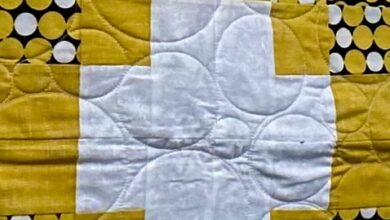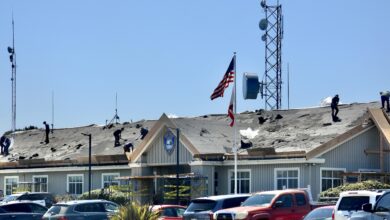Restoring our salmon: Kids restore city park, watershed, community in new joint program
America has been full of pleasant surprises for Fort Bragg Middle School student Frances Fontavilla — none bigger than the redwood trees in Otis Johnson Wilderness Park.
“I lived in a city in the Philippines, and until I came here I had never seen anything like this, the big redwoods. It”s beautiful. I could stay here all day.”
Fontavilla, whose family moved to Fort Bragg a few years ago, was one of 15 students in Fort Bragg Middle School”s MESA program (Mathematics, Engineers and Science Achievement) using Otis Johnson Wilderness Park as a living laboratory last week. They learned about native plants, the rejuvenating powers of big trees, watershed restoration, loss of salmonid habitat and the effects of logging.
The effort is a new program funded by the Salmon Restoration Association in partnership with the City of Fort Bragg, Jughandle Creek Farm and Nature Center and Fort Bragg Unified School District.
“Otis Johnson Park is used often by the youth of Fort Bragg either in school programs like cross country runners, or as a teenage getaway for a multitude of activities, and unfortunately sometimes as a place to practice acts of vandalism,” wrote Helene Chalfin of Jughandle Creek Farm and Nature Center in a successful grant application to the Salmon Restoration Association.
“Because the park is in close proximity to the Fort Bragg Middle School and because it lies within the Pudding Creek watershed, the park offers an excellent opportunity as a natural outdoor living laboratory,” she said.
Students who admitted to having been bored by the idea of watershed restoration in the classroom said everything made much more sense standing on the fern carpet under the giant redwoods.
The crowd of learners clearly enjoyed declaring war on the invasive English ivy that has spread from backyard gardens to create a virtual monoculture in some areas of the park. When the long, invasive vines were removed, it was clear from the bare ground beneath that the ivy didn”t share its space with any other plants.
Chalfin showed how a variety of ferns and other native plants would take hold, using less water and creating better cover for native critters, while helping the entire forest return to its former glory.
“The park has been invaded by non-native plants like English ivy, Himalayan blackberry and crocosmia that are changing the upland forest habitat as well as the riparian habitat from that which supported salmon and steelhead for generations,” Chalfin wrote. “In addition to re-vegetating with native plants, the City”s part of the project will consist of upgrading two stream crossings to prioritize water quality, fish and wildlife habitat.”
There were also six Noyo High School students doing work in the park at the end of the school year. The educational efforts to get more kids into the park will continue over the summer, with hopes for a bigger launch next fall, with funding from state grants through the City and the Salmon Restoration Association.
The City has acquired grant funds but the state budget has delayed that process. The Salmon Restoration Association raises funds for programs in education, watershed restoration and fisheries improvement through the annual World”s Largest Salmon Barbecue.
As school waned, student energy surged for tearing out truckloads of invasive plants, cleaning up trash and hearing how erosion and invasive species impact salmon and local water supplies.
Noyo High School senior Oralia Gaona joined in because of the small stipend and the chance to go to the World”s Largest Salmon Barbecue but was fascinated at how everything made so much more sense in the outdoors.
“I love learning outdoors with my friends. We get dirty and help clean up the park. I enjoyed learning so many plant names and their history,” said Gaona.
Redwood forests surround Fort Bragg but are generally not easy to access — with the notable exception of the six-acre wilderness right next to Fort Bragg Middle School.
Generations of kids have used Otis Johnson Wilderness Park for a hangout, even before the money for the park was donated by the widow of Otis Johnson. The Johnson family”s 19th century timber business helped establish Fort Bragg as a place people could earn a living in the lumber business. The park itself was logged about a century ago. Biologists consider it an excellent example of second growth forest but one imperiled by human activities.
“The large second growth Coast Redwood, Northern Bishop Pine, and Riparian Forest communities are reminiscent of ancient forests,” Chalfin wrote. “However, non-native English ivy, Himalayan blackberry and crocosmia threaten to take over the park”s forest and wetland habitats. The City has made a commitment to intervene, with the help of Caltrans and the State Rivers and Parkways Grant program, in a sustained effort to reverse the infestations, plant natives, and upgrade the waterway and park amenities.”
The towering second-growth forest is a testament to the healthy economic future local forests offer to younger generations. But damage to streams and hillsides caused by erosion and invasive species also teach youngsters the need to manage resources better than past generations did.
Some of the damage is caused by the kids themselves, and they can see that through this project. Kids have created vertical trails that cause erosion. Others have actually written large amounts of graffiti all over redwood trees.
Some middle school boys threw rocks at this reporter”s pickup, being used in the cleanup. Fellow students were embarrassed and revealed the identity of the perpetrators.
Teri Jo Barber, who is in charge of the project for the City of Fort Bragg likes the idea that young people claim the park as their territory, even though some now vandalize, litter and graffiti their own “turf.”
The City has been granted $178,000 from California River Parkways Proposition 50. Unfortunately these funds were frozen in late 2008 as part of the State”s budget crisis. Caltrans is also providing $235,000 for park improvements, as required by the State Water Resources Control Board to mitigate environmental damages to Ten Mile River during the construction of the new bridge. Caltrans funds will be released this summer, with work anticipated to begin in the fall.
“I continue to believe the project will help to transform the vandalism going on there by kids when they saw or are included in improving the Park — that they would gain a kind of ownership” and become pro-park visitors, a positive force in the park — especially those being given a hands-on opportunity but even those without their hands in it would still get it” through the grapevine,” Barber said.
All the partners hope that the effort can grow much bigger, involving and educating the community in the efforts to restore the city”s wild treasure.
Jughandle and the Salmon Restoration Association hope to create a program where more and more students use the park each year to learn lessons about native plants, logging and how the watershed supports the community. Chalfin has contacted many local teachers about participating. The Salmon Restoration Association is seeking to add a fish biologist to the educational agenda.
Ultimately, over time, the park will host more robust and diverse populations of native species than it does today and water quality will improve onsite and downstream for salmonids in Pudding Creek. An interpretive program will focus all park users on stewardship and water quality.
The Salmon Restoration Association is making contributions to the MESA club, while providing the students from Noyo High School small work stipends.
Jughandle Creek is working with local schools to get more teachers involved next fall in using the park as a living laboratory.
“Their investment of time, thought and effort may give them hope that their own efforts can yield a positive, valued result. That hope is increasingly important as youth struggle to find meaning and a positive niche in our increasingly complex society. Pride in their efforts may yield the side benefit of converting the park vandalism to park nurture-ism,”” Chalfin wrote.
MESA works with thousands of educationally disadvantaged California students with an interest in math and science and helps them work toward careers in math, engineering and science.
MESA works with industry partners and the University of California, California State University, the California Community Colleges, the Association of Independent Colleges and Universities and the State Department of Education. MESA is nationally recognized for its innovative academic development program, its website says.
Fort Bragg Unified School District is one of the districts to join the optional MESA program. More information can be found at www.ucop.edu/mesa/
home.html.




